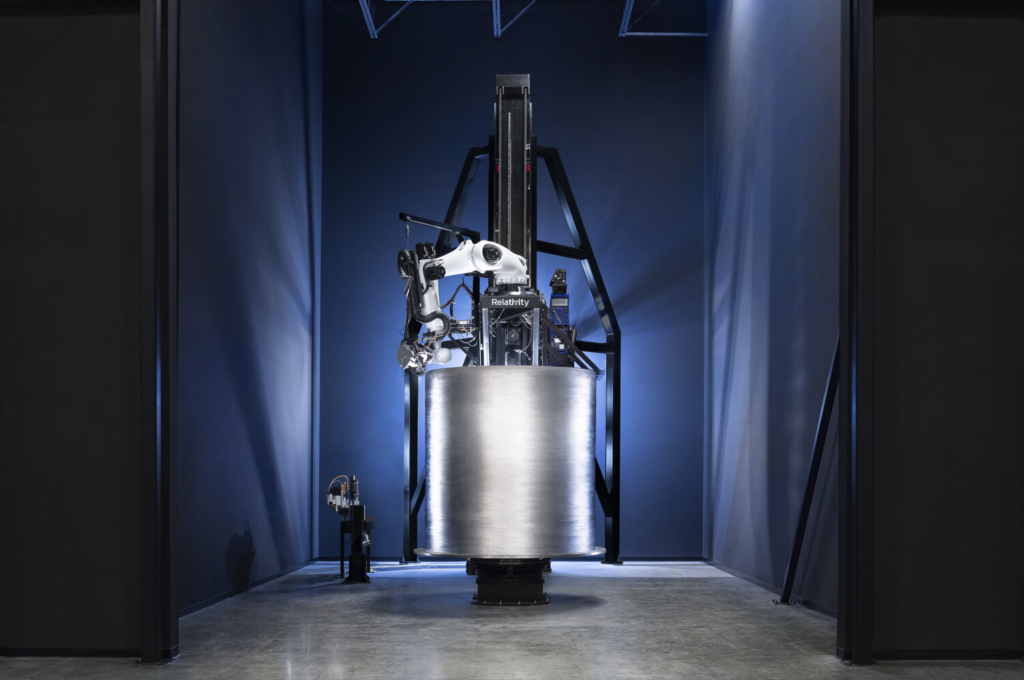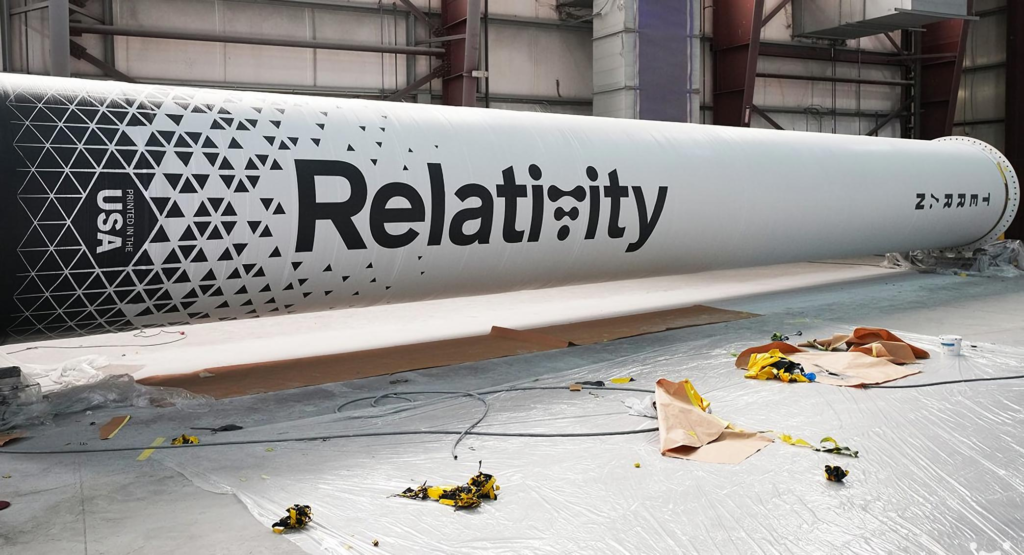
The First 3D Printed Orbital Rocket Launch Is Days Away
Back in 2015, Relativity Space was founded with the goal of changing how rockets were manufactured. Now in early 2023, Relativity is scheduled for its first launch of Terran 1, called “GLHF” (Good Luck, Have Fun), from Launch Complex 16 in Cape Canaveral, Florida. This almost fully 3D printed rocket has a lot of unique features that will be put to the test in just days.
Not long ago the company announced that it had received the necessary licensing from the Federal Aviation Administration for this mission. With this and past testing complete, practically everything is ready for the launch set to happen on March 8th. Between then and now, Relativity is continuing to make sure all the various pad and rocket systems are set for the first launch.
In addition to Terran 1’s progress, the company’s even bigger 3D printed rocket Terran R is making significant strides in development. With a lot of similar practices shared between the two, this first launch will have a big impact on the other rocket as well. Here I will go more in-depth into the upcoming mission, Terran 1’s payload, what to expect in the coming days, and more.
First Launch

Recently, after a few delays and questions regarding the timeframe of this launch, Relativity announced the official launch date of March 8th at 1 pm ET. This launch of Terran 1 is the first orbital attempt by Relativity and will not include a customer payload. The FAA license comes after a series of tests of both stages of the rocket. Relativity had planned to cap off that test campaign by firing the first-stage engines of the full vehicle on the pad. The FAA license for the launch included a “stage one hotfire” as part of the pre-launch operations covered by the license. In terms of testing, an official said “Relativity had decided not to conduct that static-fire test. The overall test campaign had “burned down risk significantly” and gave the company confidence in proceeding with a launch without another hotfire of the first stage.” Maiden flights have somewhat of an explosive history however Relativity is confident they can do it first try.
It’s important to point out that there is no official payload, and Relativity Space is instead including a small object inside the nosecone. On the 2nd they tweeted saying, “What’s inside Terran 1’s nose cone? Check out one of our very first metal 3D prints, that’s catching a ride aboard Terran 1. Printed by the 1st gen of our Stargate metal 3D printers, this print pays homage to the journey behind Terran 1’s first launch.”
As a two-stage, 110ft. tall, 7.5 ft. wide, expendable rocket, Terran 1 is the largest 3D printed object to exist and to attempt orbital flight. Working towards its goal of being 95% 3D printed, Relativity’s first Terran 1 vehicle is 85% 3D printed by mass. Terran 1 has nine Aeon engines on its first stage, and one Aeon Vac on its second stage supporting a payload capacity to LEO of 1,250kg. Relativity’s Aeon engines are designed, assembled and tested in house. Except for the second-stage nozzle extension, each of Terran 1’s 10 engines is based on a common design— enabling simplified and repeatable manufacturing and acceptance testing. Aeon engines are fueled by liquid natural gas and liquid oxygen and operate using the gas generator engine cycle. Each engine uses two turbopump assemblies for thrust and mixture ratio control: one for liquid natural gas and one for liquid oxygen. The thrust chamber is regeneratively cooled with liquid natural gas, which is then injected into the main combustion chamber and burned with liquid oxygen to produce the required thrust. Like its structure, all Relativity engines are 3D printed, and use liquid oxygen (LOX) and liquid natural gas (LNG), which are not only the best for rocket propulsion, but also for reusability, and the easiest to eventually transition to methane on Mars.
With this launch date in place, it’s very likely that Relativity will be the first to fly with this propellant combination. Other rockets such as SpaceX’s Starship and ULA’s Vulcan are very close to their maiden flights but Relativity is just days away.
As a next generation launch vehicle, Terran 1 is designed for the future of constellation deployment and resupply. Its unique and software-driven architecture is capable of accommodating satellite customers’ evolving needs, while also providing the most agile and affordable launch service on the market. Designed and printed in the USA, Relavitiy believes Terran 1 is the most innovative product to emerge from the aerospace manufacturing industry since the dawn of the privatization of space 20 years ago.
Relativity & Terran 1

It has been quite a long journey for both Relativity Space as a company and the Terran 1 rocket. Thankfully, they have both made it to easily the most difficult and important test yet with Terran 1’s first launch. Not only will this test the rocket itself, but also the pad infrastructure at Launch Complex 16. Relativity has been constructing a launch facility on site LC-16 at Cape Canaveral Air Force Station (CCAFS) meant to support initial test flights of Terran 1 and subsequent customer flights. The launch site, on the eastern end of the air force station, is ideal for supporting low- to mid-inclination orbits. Inclinations less than 28° and greater than 55° are also possible but may result in decreased mass to orbit performance due to dogleg trajectories. Before Relativity was competitively awarded the site in 2019, LC-16 was used by the US Air Force for Titan I, Titan II, and Pershing missile launches, and briefly by NASA for Gemini crew processing and static test firing of the Apollo Service Module’s propulsion engine. Since then, Relativity has been working to modernize and improve the site for ambitious future launches.
The exciting part about this upcoming launch is all the firsts that are being tested. Not only is it the first launch for Relativity, the first of Terran 1, but also the first attempt with an almost fully 3D printed rocket. The success and results of this mission are bound to have a lasting effect on the manufacturing process that Relativity uses and any changes they make going forward with this rocket and even Terran R.
Relativity’s proprietary Factory of the Future centers on Stargate, the world’s largest metal 3D printers, that create Terran 1, and the first fully reusable, entirely 3D printed rocket, Terran R, from raw material to flight in 60 days. If these systems continued to be improved and new generation printers come out, its possible that Relativity can keep improving the strength, time, and money needed to produce these rockets. Stargate printers’ patented technology enables an entirely new value chain and innovative structural designs that make Terran 1 and Terran R possible. The company points out that by developing its Factory of the Future and rockets together, Relativity accelerates its ability to improve design, production, quality, and speed. Relativity developed multiple proprietary alloys custom designed for 3D printing to meet mission-critical performance. In terms of uniformity, parts are inspected during and after printing to ensure they meet the highest standards of quality.
In the grand scheme of things, Relativity is trying to change how rockets are manfucutured within the industry. They often highlight that for around 60 years, aerospace manufacturing has relied on large factories, fixed tooling, complex supply chains, and extensive manual labor to build costly rockets comprised of 100,000+ parts in 2 years or longer. In order to accelerate innovation in the industry, Relativity built its Factory of the Future, the first aerospace platform to automate rocket manufacturing, vertically integrating intelligent robotics, software, and data-driven 3D printing technology. Incorporating Stargate, the world’s largest metal 3D printer with AI-driven controls, its Factory of the Future continuously optimizes production, resulting in greatly compounded quality and time improvements, lower costs, and product designs previously not possible. Relativity is an application-layer 3D printing company that is starting with rockets, and will extend its Factory of the Future to all of aerospace. Almost all of which will be somewhat impacted by this first launch.
In terms of launch operations, usually, approximately one week prior to launch, Relativity conducts a flight readiness review (FRR) to verify readiness of the launch vehicle, integrated payload, and ground systems. Once verified, the integrated Terran launch vehicle rolls to the pad and connects to ground systems including payload/fairing conditioning, pressurants, propellants, and electrical and data connectivity. When ground support connections are complete, the transporter erector rotates the Terran launch vehicle to its vertical position on the pad. The Terran launch vehicle and pad systems are designed to accommodate a one-hour countdown; longer countdowns may be coordinated as a nonstandard service. Critical functions for both ground systems and flight vehicle are controlled by automated software during the countdown. Propellant and pressurant loading sequences begin early in the countdown, along with a series of vehicle, telemetry, and range checkouts, with verification of AFSS, transmitter activation, and transitions from ground to internal power taking place during the final minutes of terminal count.
Conclusion
Relativity Space is officially less than 3 days away from the company’s most important test yet. This will highlight not only what they and the Terran 1 rocket are capable of, but also the 3D printing process and whether or not it’s viable for this application. We will have to wait and see how it progresses and the impact it has on the space industry.